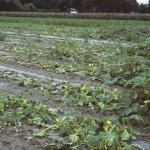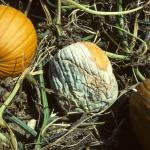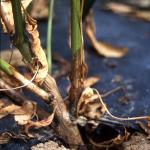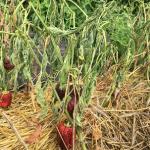Phytophthora Blight
Phytophthora capsici
Phytophthora blight, caused by the oomycete Phytophthora capsici, causes a root, crown and fruit rot of cucurbits, tomato, pepper, and eggplant. Phytophthora blight was first reported on peppers in 1922 and on cucurbits in the 1930s, and infections occurred sporadically until the 1980s, when disease incidence started rapidly increasing. It is now one of the most devastating diseases of solanaceous and cucurbit crops, most notably of winter squash and peppers, and can cause total crop loss.
Identification:
P. capsici can cause root, crown, and fruit rot in pepper, tomato, eggplant, and all cucurbits. In tomato, P. capsici is one of the pathogens that can cause buckeye rot of tomato fruit.
In cucurbits, root and crown rot caused by P. capsici appears suddenly as a permanent wilt due to root infection following rain or irrigation. Roots and stems near the soil line will appear water-soaked, dark brown in color, and will become soft. Whole plants or vines collapse quickly. In peppers, P. capsici causes distinctive black lesions to form on stems. Infected stems remain rigid but foliage and fruit wilt and wither, and remain attached to the plant.
Cucurbit and tomato fruit can become infected at any stage of maturity, either from direct contact with the soil or from splashing rain or irrigation. Initially, symptoms will appear as small water-soaked areas that quickly enlarge and can become covered in sporangia in high humidity. Sporangia-covered lesions will have a yeast-like, gray to white appearance. The rot will develop rapidly until the fruit is completely collapsed. Disease will develop particularly rapidly following harvest. Pepper fruit may develop similar lesions, but more commonly becomes infected systemically, through the plant roots and rots on the plant as described above. Pepper leaves may also be infected by zoospores dispersed by splashing water, and will develop lesions similar to those on fruit.
Life Cycle:
Phytophthora blight is a polycyclic disease, meaning that under favorable conditions, the pathogen will re-infect crops several times throughout the growing season. P. capsici has two mating types (called A1 and A2) that are morphologically identical but genetically distinct. When both mating types are present in one field, they mate to produce survival structures called oospores. Oospores can survive in the soil for many years and provide the initial inoculum for disease initiation in the spring when conditions become favorable. The asexual stage of P. capsici, which is responsible for initiating infection, depends on water for infecting and moving between plants. Disease will almost always begin in low spots of fields or in areas that do not drain readily. When contaminated soils are saturated for several hours and temperatures are relatively warm, P. capsici will form structures called sporangia, which contain asexual, swimming zoospores that are released into the saturated soil. Zoospores are attracted to living plant parts in the soil and on the soil surface and swim toward them. Once they find a host plant, zoospores can germinate and infect any plant part either in the soil (roots, crowns) or via splashing water (leaves, fruit).
Oospores are spread from field to field in infested soil adhering to machinery or humans. Zoospores are spread primarily through water—splashing water from irrigation or rain, or water running through fields during irrigation or rain events. If contaminated field runoff or water used to wash contaminated equipment drains into an irrigation pond, that irrigation pond may become a source of inoculum and spread the pathogen throughout the crop or onto other fields.
Researchers in Michigan have shown that P. capsici can move in river water, although a 2013-2014 UMass survey in the Connecticut River Valley did not find the pathogen in the Connecticut River.
Crop Injury:
Yield is reduced when whole sections of plants collapse due to disease, fruit is infected in the field, or infected fruit is harvested and disease develops in transport or storage. Complete loss of the crop can occur when infection is severe.
Cultural Controls & Prevention:
Whether you are in an infested or uninfested field, the critical goal is to manage water so that there is never standing water for longer than 24 hours anywhere in the field. If you must grow crops in a field with a past history of Phytophthora blight, there are some management practices that will help reduce disease. Extended periods of rain are very likely to result in significant disease development if the pathogen is present no matter what you do, but the practices outlined below may help your crops survive under moderate conditions.
- Keep records of contaminated fields. Do not rent land for susceptible crops without investigating the history of disease problems.
- Avoid planting susceptible crops in Phytophthora-infested soil. Rotate with corn, small grains, brassicas, alliums, or other non-hosts
- Separate susceptible crops (if possible) such that there is no opportunity for water to move from one planting to another.
- Don’t plant low areas to susceptible crops—plant a cover crop, corn or another non-susceptible crop, or leave it bare. (Better a small loss in yield than a total loss of the crop.)
- Avoid introducing Phytophthora into uninfested fields. After working in Phytophthora-infested soil, wash soil from equipment. Always work in clean fields before working in infested fields.
- Rotation: A minimum crop rotation of 3-4 years is recommended, although fields that have been out of susceptible crops for >5 years have had outbreaks in recent years. Planting non-hosts into infested fields for any number of years is useful—each year an infested field is planted with a non-host, the number of surviving oospores will be reduced. The host range of P. capsici is broad but the list of non-hosts includes brassicas, carrots, onions, and small grains. Tolerant pepper varieties are available if crop rotation is impossible. Similarly, pumpkin varieties with hard shells, such as ‘Lil Ironsides’ or ‘Apprentice’ have been shown to be significantly less susceptible to disease than similar varieties with conventional, soft rinds.
- Resistant Varieties: Plant resistant varieties whenever possible. Pumpkins with hard, gourd-like rinds are less susceptible to Phytophthora fruit blight. ‘Lil' Ironsides’, ‘Apprentice‘, IronMan’, ‘Rockafellow’, and ‘CannonBall’ have been reported as moderately resistant. ‘IronMan’, ‘CannonBall’, and ‘Rockafellow’ also possess powdery mildew resistance. Bell peppers that are relatively more resistant include ‘Conquest’, ‘Paladin’, and ‘Emerald Isle’.
- Water management: Phytophthora requires saturated soils for infection. Use the following methods to encourage drainage and avoid prolongued soil saturation.
- Be careful to not overwater.
- Check irrigation system regularly for leaks and fix them.
- Break up hardpan and encourage drainage by using a V-ripper or other sub-soiling tool between rows, or deep vertical tillage equipment in-row. Do this pre-planting and as needed during the season.
- Avoid soil compaction. Use farm machinery as little as possible throughout the season and never work in fields when the soil is wet.
- Plant non-vining cucurbit crops (i.e. summer squash) and peppers in dome-shaped raised beds of at least 9 inches height. Use a transplanter that does not leave a depression around the base of the plant.
- Make sure water can flow out of the field. Create breaks in raised beds and clear away soil at the ends of rows to prevent damming.
- Mulch between rows and on bare soil with straw or leave cover crop stubble to reduce splash dispersal of inoculum. Inoculum can move rapidly across black polyethylene mulch and bare soil.
- Biofumigation: Research has shown that brassica cover crops (especially mustards) release glucosinolates and other compounds as they break down that are toxic to microorganisms, including plant pathogens. Plant pathogens are not always great soil competitors, so this “biofumigation” allows beneficial microorganisms to repopulate the soil. In order to get the highest release of glucosinolates, the brassica cover crop should be fertilized. At termination, incorporate the brassica residues by chopping and rototilling, followed by cultipacking and irrigating just before the crop is planted. Allelopathy can be a concern for some sensitive crops when using this system. For more detailed info check out this factsheet from Cornell University.
- Practice good sanitation and do not discard cull fruit in the field.
- Combining no-till cover crop production with moderately resistant varieties can reduce fungicide inputs, resulting in reduced production costs and delay the development of fungicide resistance in pathogen populations. A healthy soil microbial community can reduce plant pathogen activity by outcompeting them for space and nutrients, by direct parasitism of plant pathogens, by producing antibiotic compounds that slow pathogen growth, and by stimulating the plants’ natural defense systems.
- When symptoms are localized in a small area, disking the area may be worthwhile.
Chemical Controls & Pesticides:
Phytophthora blight cannot be managed by fungicide applications alone; successful disease control in infested fields is achieved only by a season-long effort to manage water and utilize other cultural practices. Fungicide programs for managing Phytophthora blight must be preventive and require multiple applications throughout the season. Many New England growers may decide the cost of materials and spraying is not economical, especially in winter squash production. Fungicides may be easier to apply and more effective in pepper fields where drip irrigation line is used in conjunction with raised, plastic-mulched beds.
While mefenoxam/mancozeb (e.g. Ridomil, Apron) has been recommended for years, over-dependence on these materials has led to resistance within some field populations. Other broad spectrum materials to consider would be: copper compounds (e.g. Kocide, Basic Copper 53, Champ 2F); the phosphorous acid fungicides (e.g. Prophyt, K-phite, Agri-fos), which can be used as drench treatments at plant and as follow-up applications to foliage; biofungicides such as Bacillus spp. (e.g. Serenade, Double Nickel, Taegro), Trichoderma spp. (e.g. Root Shield Plus), or Streptomyces spp. (Actinovate, Mycostop), which can be used as broad-spectrum protectants applied at plant and as follow-up applications through drip-lines or to foliage, though their efficacy is generally lower than conventional pesticides.
In addition to broad spectrum protectant fungicides, many targeted materials are labeled, but in order to be effective they must be used preventively and in a rotational program to manage resistance development. In cucurbits these include Presidio (FRAC 43), Ranman (FRAC 21), Zing! And Gavel (FRAC 22), Zampro and Revus (FRAC 40), Curzate or Tanos which may have some curative effect (FRAC 27). For pepper, in addition to those materials previously listed, the following could be used: Omega 500 (FRAC 29), and Reason 500 (FRAC 11), which is labeled for suppression only.
For organic growers, there are several soil-applied materials labeled for use in controlling Phytophthora species including P. capsici, and while they may not work as well as targeted synthetic fungicides, they can reduce disease severity and improve yield. 2013 trials conducted by Dr. Mary Hausbeck at Michigan State University found that BioTam, Serenade Soil, and Actinovate Ag all significantly reduced plant death and increased yield relative to the untreated control. Each product was applied as a soil drench at the base of yellow squash plants grown on black plastic. When she used these biofungicides in rotation with a synthetic fungicide, Presidio, she got even better control, indicating these materials could be used as rotational tools in conventional spray programs. The full report from these trials is available here.
For the most up-to-date information on chemical controls please consult the New England Vegetable Management Guide and always follow label instructions carefully.
Crops that are affected by this disease:
The Center for Agriculture, Food and the Environment and UMass Extension are equal opportunity providers and employers, United States Department of Agriculture cooperating. Contact your local Extension office for information on disability accommodations. Contact the State Center Director’s Office if you have concerns related to discrimination, 413-545-4800 or see ag.umass.edu/civil-rights-information.







